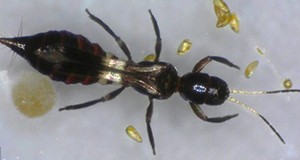Abstract
Franklinothrips vespiformis Crawford is a predatory thrips with a pantropical distribution. The distinctive red, humped-back larvae and fast-moving ant-like adults are predaceous on small arthropods. In addition to being easily mistaken for an ant, this beneficial thrips is unusual in that it constructs a silken cocoon within which it pupates. Males of this species are rare. This species is sold for use as a biological control agent in botanical gardens, zoos, interior landscapes, research greenhouses, nurseries with ornamental plants as well as outdoors in subtropical regions. This 4-page fact sheet was written by Runqian Mao, Yingfang Xiao, and Steven P. Arthurs, and published by the UF Department of Entomology and Nematology, March 2015. (Photo credit: Runqian Mao, UF/IFAS)
References
Ananthakrishnan TN. 1993. Bionomics of thrips. Annual Review of Entomology 38: 71-92. https://doi.org/10.1146/annurev.en.38.010193.000443
Arakaki N, Okajima S. 1998. Notes on the biology and morphology of a predatory thrips, Franklinothrips vespiformis (Crawford) (Thysanoptera: Aeolothripidae): First record from Japan. Entomological Science 1: 359-363.
Callan E. 1943. Natural enemies of the cacao-thrips. Bulletin of Entomological Research 34: 313-321. https://doi.org/10.1017/S0007485300023828
Cox PD, Matthews L, Jacobson RJ, Cannon R, MacLeod A, Walters KFA. 2006. Potential for the use of biological agents for the control of Thrips palmi (Thysanoptera: Thripidae) outbreaks. Biocontrol Science and Technology 16: 871-891. https://doi.org/10.1080/09583150600827728
Entocare CV. 2013. Natural enemies thrips. Wageningen Pest Control. (February 10, 2015)
Greathead DJ, Greathead AH. 1992. Biological control of insect pests by insect parasitoids and predators: the BIOCAT database. Biocontrol News and Information, 13: 61N-68N. https://doi.org/10.1079/cabireviews/19921166435
Hoddle MS. 2003a. The effect of prey species and environmental complexity on the functional response of Franklinothrips orizabensis: A test of the fractal foraging model. Ecological Entomology 28: 309-318. https://doi.org/10.1046/j.1365-2311.2003.00518.x
Hoddle, MS. 2003b. Predation behaviors of Franklinothrips orizabensis (Thysanoptera: Aeolothripidae) towards Scirtothrips perseae and Heliothrips haemorrhoidalis (Thysanoptera: Thripidae). Biological Control 27: 323-328 https://doi.org/10.1016/S1049-9644(03)00023-9
Hoddle MS, Mound LA, Paris DL. 2012. Thrips of California. CBIT Publishing, Queensland. (February 14, 2015)
Hoddle MS, Oevering P, Philips PA, Faber BA. 2004. Evaluation of augmentative releases of Franklinothrips orizabensis for control of Scirtothrips perseae in California avocado orchards. Biological Control 30: 456-465. https://doi.org/10.1016/j.biocontrol.2004.01.009
Hoddle MS, Oish K, Morgan D. 2001a. Pupation biology of Franklinothrips orizabensis (Thysanoptera: Aeolothripidae) and harvesting and shipping of this predator. Florida Entomologist 84: 272-281. https://doi.org/10.2307/3496179
Hoddle MS, Jones J, Oishi K, Morgan D, Robinson L. 2001b. Evaluation of diets for the development and reproduction of Franklinothrips orizabensis (Thysanoptera: Aeolothripidae). Bulletin of Entomological Research 91: 273-280. https://doi.org/10.1079/BER200197
Hood JD. 1913. On a collection of Thysanoptera from Panama. Psyche 20: 119-124. https://doi.org/10.1155/1913/48394
Larentzaki E, Powell G, Copland MJ. 2007a. Effect of temperature on development, overwintering and establishment potential of Franklinothrips vespiformis in the UK. Entomologia Experimentalis et Applicata 124: 143-151. https://doi.org/10.1111/j.1570-7458.2007.00556.x
Larentzaki E, Powell G, Copland MJ. 2007b. Effect of cold storage on survival, reproduction and development of adults and eggs of Franklinothrips vespiformis (Crawford). Biological Control 43: 265-270. https://doi.org/10.1016/j.biocontrol.2007.08.012
Loomans AJM, Vierbergen G. 1999. Franklinothrips: perspectives for greenhouse pest control. Bulletin OILB/SROP 22(1): 157-160.
Mahaffey LA, Cranshaw WS. 2010. Thrips species associated with onion in Colorado. Southwestern Entomologist 35: 45-50. https://doi.org/10.3958/059.035.0105
Moulton D. 1932. The Thysanoptera of South America. Revista de Entomologia 2: 464-465.
Mound LA, Reynaud P. 2005. Franklinothrips; a pantropical Thysanoptera genus of ant-mimicking obligate predators (Aeolothripidae). Zootaxa 864: 1-16. https://doi.org/10.11646/zootaxa.864.1.1
Okajima S, Hirose Y, Hakita H, Takagi M, Naponpeth B, Buranapanichpan S. 1992. Thrips on vegetable in Southeast Asia. Applied Entomology and Zoology 27: 300-303. https://doi.org/10.1303/aez.27.300
Pizzol J, Nammour D, Ziegler JP, Voisin S, Maignet P, Olivier N, Paris B. 2008. Efficiency of Neoseiulus cucumeris and Franklinothrips vespiformis for controlling thrips in rose. ISHS Acta Horticulturae 801: 1493-1498. https://doi.org/10.17660/ActaHortic.2008.801.184
UK CAB International 2010. Franklinothrips vespiformis datasheet. (February 14, 2015)

